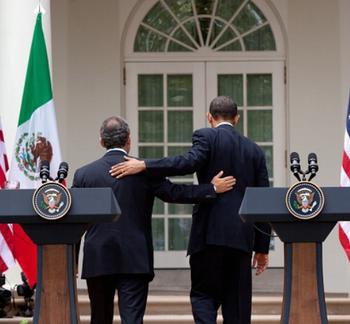U.S., Mexican Leaders Say No to Gulf Oil, Yes to Renewables
WASHINGTON, DC, May 21, 2010 (ENS) - Due to the ongoing Deepwater Horizon oil spill, President Barack Obama and Mexican President Felipe Calderon have agreed to seek a moratorium on oil exploration and production near the Western Gap of the Gulf of Mexico, where the two countries share a maritime border.
The leaders "instructed their teams to seek a moratorium on exploitation activities along the maritime boundary in the Western Gap," they said in a joint statement released Thursday in Washington.
In June 2000, both countries put a 10-year production moratorium in place for the Western Gap area. The U.S. government placed a moratorium on new drilling permits in all offshore waters at least through the end of May. Any new agreement should be "consistent with the findings of key investigations into the BP Deepwater Horizon oil spill," the two Presidents said.
As the broken well continues to spill oil into the gulf at an estimated rate of up to 100,000 barrels a day, as it has since the deadly explosion April 20, President Obama thanked President Calderon for the offers of assistance Mexico has provided in accordance with the United States-Mexico Joint Contingency Plan for Maritime Pollution.
 |
President Barack Obama and President Felipe Calderon in Washington, May 19, 2010. (Photo courtesy Office of President Calderon) |
On other energy and environmental matters, the two Presidents agreed to create a Cross-Border Electricity Task Force to promote regional renewable energy markets between the two countries.
The Task Force will advance options on standards, electricity transmission, grid connections, and other policy measures that create market incentives for cross-border investment and trade in renewable energy technologies.
The leaders agreed to increase grid reliability and resiliency, and to collaborate on smart grid standards and technology to make energy use more efficient and reliable in both countries.
In a joint statement, the two Presidents recognized "the close link between economic growth, competitiveness, and sustainable development and their bilateral clean energy and environment agenda."
They reaffirmed the common goal of "achieving strong economic growth while addressing the climate change challenge and increasing the reliability of our energy infrastructure."
Saying that "the cleanest source of energy is more efficient energy use," the Presidents announced plans to conduct joint workshops this fall to accelerate energy efficiency improvements in the building and transportation sectors, including green building certification, enhanced trade in green building materials, and best practices in light-duty vehicle mileage regulation.
 |
President Calderon, left, and President Obama return to The White House after their joint statement. (Photo by Lawrence Jackson courtesy The White House) |
The Presidents agreed to explore the possibility of early action to liberalize tariffs on climate-friendly technologies as a first step towards encouraging mutually supportive trade and climate policies.
The two leaders reaffirmed their shared commitment to the United Nations Framework Convention on Climate Change, UNFCCC, and stressed the importance of reaching a successful outcome in Cancun, Mexico. There, the UN's annual two-week climate summit will take place starting on November 29.
President Obama supported Mexico's leadership role as chair of the 16th Conference of the Parties of the UNFCCC. He expressed readiness to work with Mexico to move the world toward an agreement limiting greenhouse gas emissions to take effect at the end of 2012 when the first commitment phase of the Kyoto Protocol expires.
In their joint statement in Washington, both leaders underscored their commitment to the Copenhagen Accord and its implementation.
The two Presidents support the Copenhagen Accord but many Latin American countries do not, saying a legally binding agreement is needed to address the worst effects of climate change, rather than this voluntary accord.
To protect a fragile desert ecosystem that spans the border, Presidents Obama and Calderon agreed to designate the Big Bend-Rio Bravo area as "a natural area of binational interest."
They recognized that Big Bend National Park and Rio Grande Wild and Scenic River in the United States and the Protected Areas of Maderas del Carmen, Canon de Santa Elena, Ocampo, and Rio Bravo del Norte in Mexico together comprise "one of the largest and most significant ecological complexes in North America."
To preserve this region of "extraordinary biological diversity," the Presidents expressed their support for the U.S. Department of the Interior and the Mexico's Secretariat of Environment and Natural Resources to manage the region in a way that "enhances security and protects these areas for wildlife preservation, ecosystem restoration, climate change adaptation, wildland fire management, and invasive species control."
Copyright Environment News Service (ENS) 2010. All rights reserved.
To subscribe or visit go to: http://www.ens-newswire.com